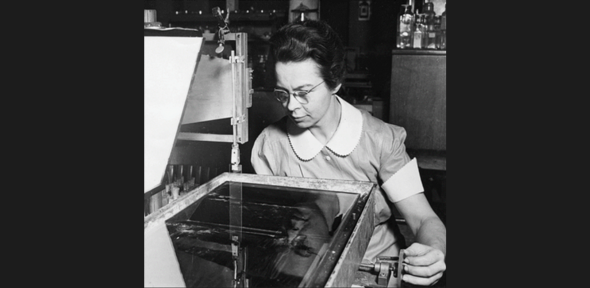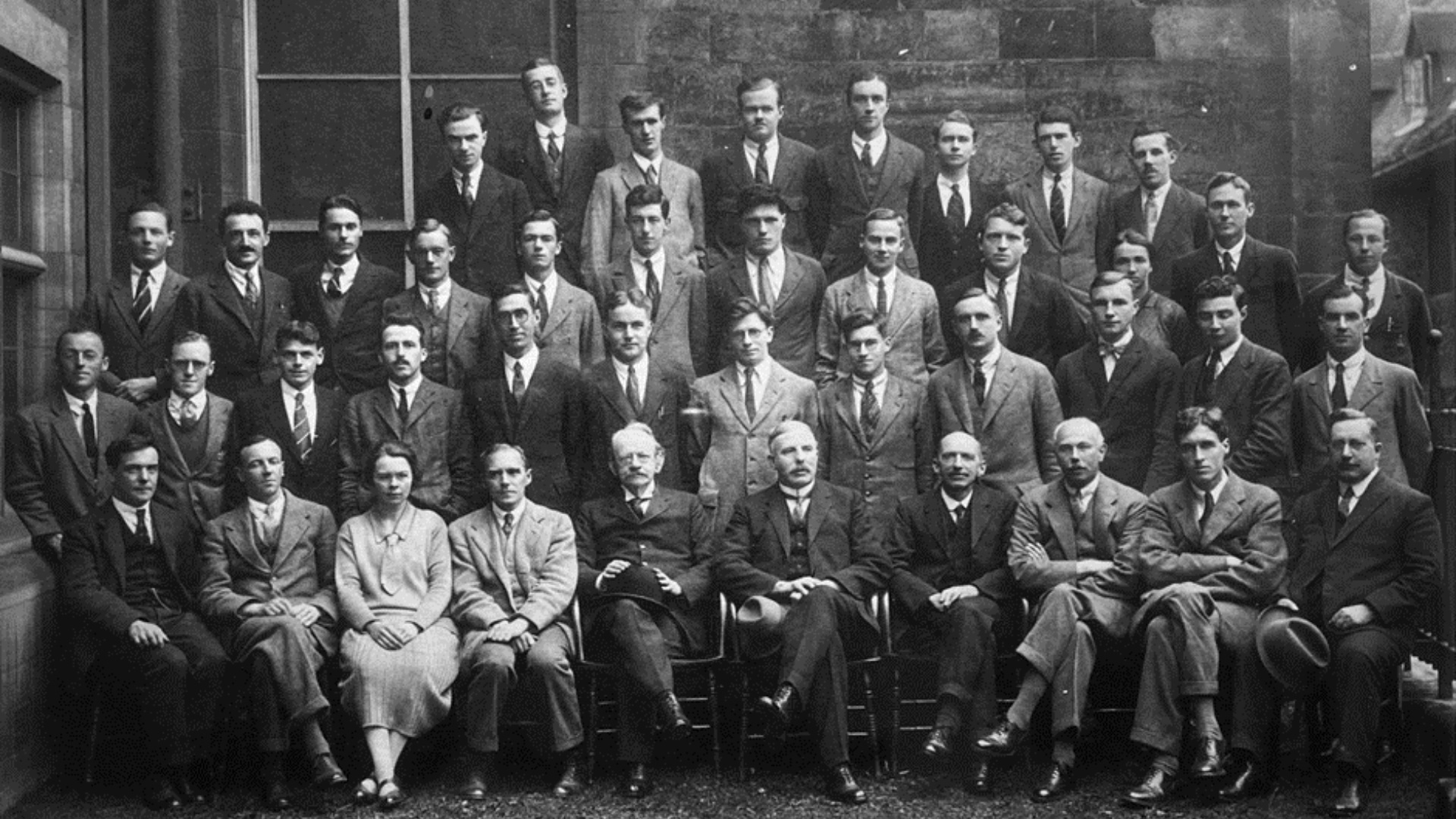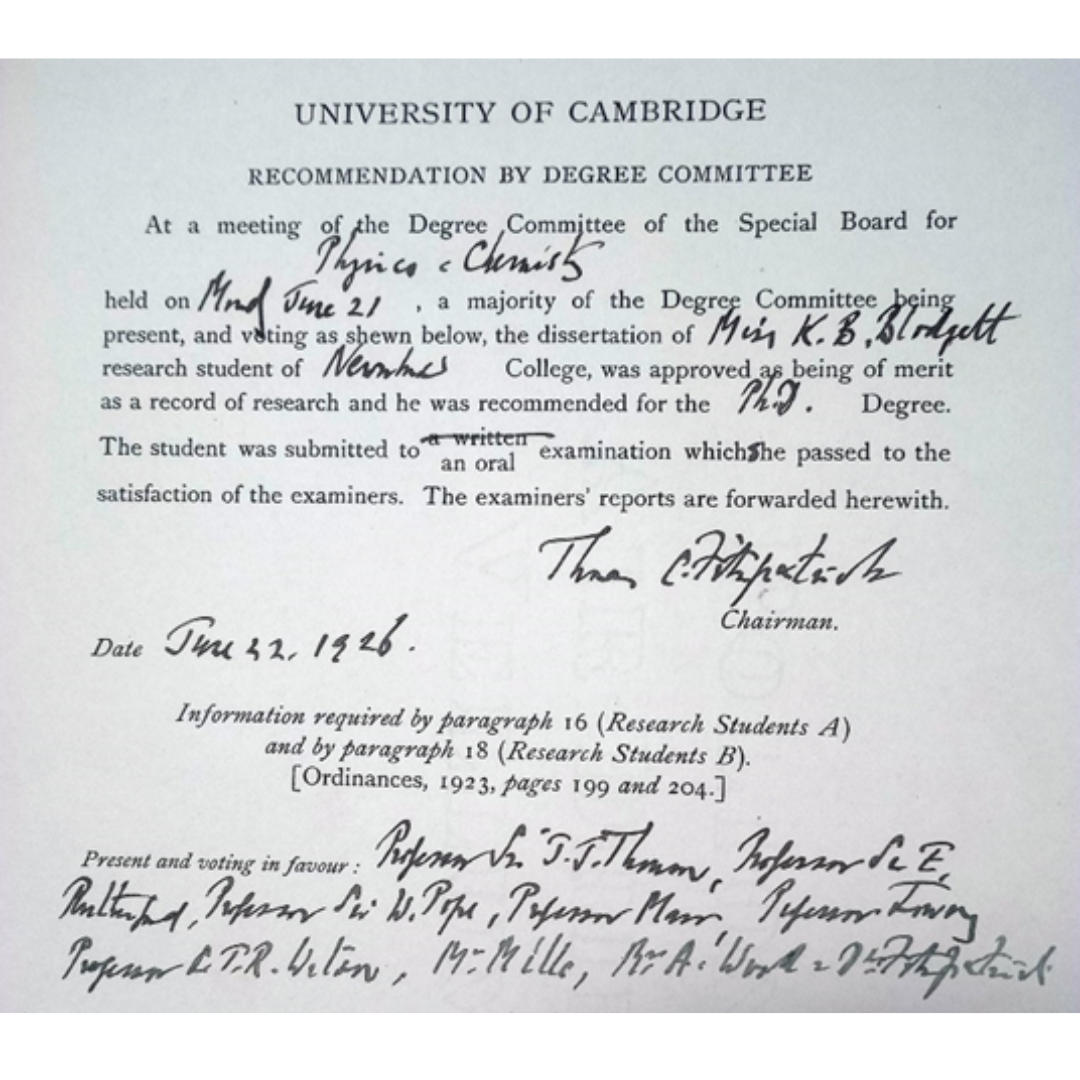
In a historic photograph from 1926, amidst a distinguished group of scientists at Cavendish Laboratory, sits Katharine Blodgett, a trailblazer in the world of physics. This image encapsulates her unique place in history as the first woman to earn a Ph.D. in Physics from Cavendish Laboratory in 1926 – the degree had only been established in 1919.
In the world of science, there are pioneers whose work not only reshapes their field but also removes barriers of inequality. Katharine Blodgett, a pioneering physicist of the 20th century, is a name that stands out vividly in this regard. Her groundbreaking research not only revolutionised multiple industries related to optics but also symbolizes the triumph of persistence and innovation over the glass ceiling that once restricted women's advancement in scientific fields.
Figure 1. The Cavendish staff-Graduate student annual photograph from 1926. Katharine Blodgett is third from the left in the front row, sitting among a galaxy of distinguished scientists, from left to right, Kapitsa, Chadwick, KBB, Taylor, Thomson, Rutherford, Wilson, Aston, Blackett and Chamberlain.
Born in Schenectady, New York, Katharine Blodgett's journey to scientific greatness was marked by a relentless pursuit of knowledge and unwavering determination. Her academic path led her to Bryn Mawr College, where she found inspiration in the teachings of eminent professors such as Charlotte Angas Scott and James Barnes. Yet, it was Irving Langmuir, a close family connection and a future Nobel laureate, who would become the pivotal figure in her career.
Langmuir offered Katharine a rare opportunity: a research position at General Electric (GE), contingent upon her completing her higher education. Determined to seize this chance, she completed a master's programme at the University of Chicago in 1918, where she contributed, under the guidance of Harvey B. Lemon, to the development of charcoal filtering applications crucial for gas masks in the World Wars. This work earned her scientific acclaim and marked her entrance into the male-dominated field of science as the first woman scientist at GE.
Katharine’s ambition did not stop there - she set her sights on earning a Ph.D. With the strong support of Langmuir, she embarked on a transformative period at the Cavendish Laboratory, University of Cambridge (Figure 1). Under the supervision of Sir Ernest Rutherford, a towering figure in the world of physics, her scientific career reached new heights. Her research at the Cavendish explored the behaviour of electrons in mercury vapor. Her final research thesis, ‘A method of measuring the mean free path of electrons in ionized mercury vapor’, was highly lauded by the degree committee.
"She has certainly shown much originality and experimental skill in the examination of her problem. She has made substantial contributions to our knowledge in this most difficult field of investigation … (the Board members) consider the thesis of undoubted merit and originality and can strongly recommend the candidate for the degree of Ph.D." said Rutherford in his recommendation for awarding Katharine the PhD degree.
Figure 2. The approval of Blodgett’s PhD dissertation by the Faculty Board of Physics and Chemistry. ©University Library Archives
During her time at the laboratory, she made significant breakthroughs in smoke screening technologies, making the vaporization of oil more efficient—a critical innovation that would make smoke screening more effective during World War II.
But it was her work with ‘invisible glass’ that would leave an indelible mark on science and technology. On her return to the GE, Katharine’s pioneering research led to the creation of multilayer anti-reflective coatings on glass. While Irving Langmuir had previously developed the process for single atomic layers, Blodgett took this further and advanced the technique for use with polymers on glass, enabling the creation of multiple layers that rendered the glass truly invisible. These innovations, known as Langmuir–Blodgett films, were the world's first 100% transparent or truly invisible glass.
The Langmuir-Blodgett film deposition process allows molecules to be deposited in a single layer across a solid surface, a breakthrough in film deposition processes and still widely used in manufacturing applications today. This groundbreaking innovation eliminated distortions caused by reflected light in a wide range of optical equipment, from eyeglasses to microscopes.
The impact of Blodgett's work transcended the scientific realm and entered the world of cinema. The iconic film ‘Gone with the Wind’ (1939) was the first major cinematic production to use Blodgett's invisible glass. The film was noted for its crystal-clear cinematography. Blodgett's nonreflective lenses also played essential roles in submarine periscopes and airplane spy cameras during World War II besides being used in projectors and cameras by the post-war movie industry. Her excellence as an experimental physicist led her to obtain eight U.S. patents for industrial applications of her discoveries during her career, cementing her legacy as a pioneering scientist and inventor.
Katharine Blodgett's life and work serve as a testament to the profound impact of persistent dedication and innovation, regardless of gender barriers. Her legacy continues to inspire generations of women scientists. As we remember her scientific contributions, we also celebrate her spirit of trying to break the glass ceiling, exemplified by her ‘invisible glass’—a metaphorical and literal breakthrough that transformed the world of science and paved further the way for future women scientists.
Main Image: Katharine Burr Blodgett (1898 – 1979) demonstrating equipment in the laboratory © Wikimedia commons
This article originally appeared in CavMag issue 30 (October 2023)


